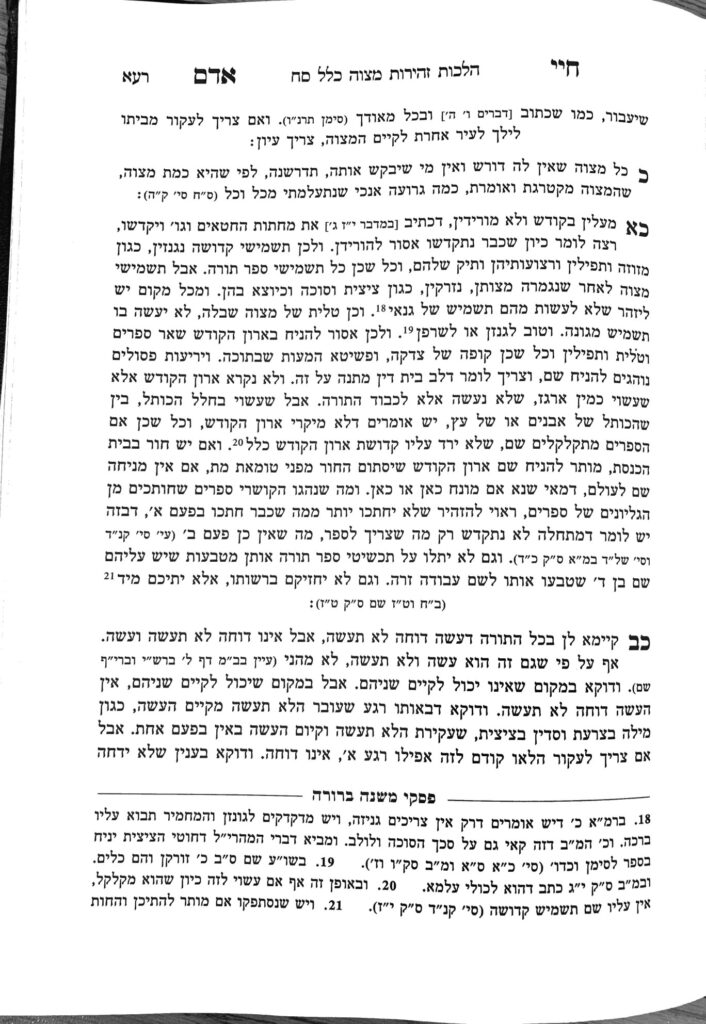We are beginning siman 22, regarding the concept of asei docheh lo saasei. Before we begin, we must realize that a person should not pasken shailos of this nature by themselves, but we will learn some of the general principles behind the concept.
The Chayei Adam introduces a rule about how to approach conflicts between mitzvos. One of the rules used to arbitrate such a question is asei docheh lo saasei, that a mitzvas asei will push (ie, supersede) a lo saasei. This rule is discussed primarily in the first perek of Yevamos. It is interesting to understand the hashkafa behind this halacha, as a person who transgresses a lo saasei is liable to malkus, while there is no punishment from the Torah for transgressing an asei. Chazal discuss that it is appropriate for such a person to bring a korban, but it is not a chiyuv from the Torah. Based on that logic, one would think that it would be more appropriate to fulfill the lo saasei rather than the asei.
The Ramban on Chumash (Parshas Yisro) explains that a mitzvas asei is a person’s act of reaching out to Hashem and demonstrating love, while a lo saasei is an expression of yirah. Obviously, a person who has ahavah will demonstrate yirah as well, and vice versa, but Rav Hutner explains that the concept of ahavah is the idea of expanding and connecting, while yirah is the idea of contracting and pulling into oneself. Thus, the Ramban explains that the idea of expanding beyond ourselves is more powerful than contracting, so an asei will override a lo saasei.
The Chayei Adam writes that when one has the opportunity to fulfill a mitzvas asei, it overrides a mitzvas lo saasei. However, in a case where there is an asei on the one hand, and an asei and lo saasei on the other, or even where there is both an asei and lo saasei on either side, one does not override one option for the other. In such a case, we pasken that shev v’al taaseh, to sit and hold back from any action is preferable.
The Chayei Adam clarifies that this concept of asei docheh lo sassei only applies when it is impossible to fulfill both the asei and lo saasei. However, if there is a way to fulfill both, the asei does not override the lo saasei.
Similarly, this concept only applies when the asei is fulfilled and the lo saasei is transgressed simultaneously. For example, if a child develops tzaraas on his orlah and needs a bris milah, the asei of bris milah overrides the lo saasei of cutting the tzaraas. Similarly, the mitzvah of techeles must be with wool strings. One may use a linen garment with wool strings, because they are fulfilling the asei while simultaneously transgressing the lo saasei.
Summary
- Asei docheh lo saasei applies when there is a conflict between a single asei and single lo saasei only. If there are other asei’s or lo saasei’s on either side, one should be shev v’al taaseh.
- Asei docheh lo saasei applies only when it is impossible to fulfill both the asei and lo saasei,
- Asei docheh lo saasei applies only where the asei is fulfilled and the lo saasei is transgressed simultaneously.
- We are learning this siman to familiarize ourselves with the general rules, but a person should not pasken shailos of this nature by themselves.



